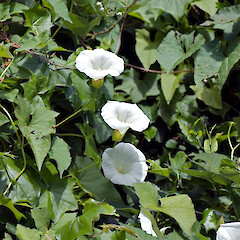Calystegia silvatica subsp. disjuncta
Common name
great bindweed
Family
Convolvulaceae
Flora category
Vascular – Exotic
Structural class
Lianes & Related Trailing Plants - Dicotyledons
Conservation status
Not applicable
Habitat
Terrestrial. Gardens, waste places, forest edges, roadsides etc
Wetland plant indicator status rating
Information derived from the revised national wetland plant list prepared to assist councils in delineating and monitoring wetlands (Clarkson et al., 2021 Manaaki Whenua – Landcare Research Contract Report LC3975 for Hawke’s Bay Regional Council). The national plant list categorises plants by the extent to which they are found in wetlands and not ‘drylands’. The indicator status ratings are OBL (obligate wetland), FACW (facultative wetland), FAC (facultative), FACU (facultative upland), and UPL (obligate upland). If you have suggestions for the Wetland Indicator Status Rating, please contact: [Enable JavaScript to view protected content]
FACU: Facultative Upland
Occasionally is a hydrophyte but usually occurs in uplands (non-wetlands).
Detailed description
Perennial herb with extensive and far creeping white rhizomes. Vigorously twining glabrous stems, to 2m or more. Lamina usually glabrous, dark green, triangular-ovate, sagiittate or hastate, base deeply cordate with rounded sinus. Flowers always singly, peduncles usually 8-20cm long. 2 large overlapping bracts at base of flower, enclosing the sepals. Corolla usually 5-8cm long almost always pure white, usually funnel-shaped. Capsule 1-1.5cm rounded and brown, with triangular-ovoid black seeds (Webb et al 1988 with additions from Melanie Newfield).
Similar taxa
Distinguished by the dark green, glabrous leaves, large pure white flowers and large overlapping bracts at the base of the flowers. Hybridises freelly with the indigenous C. sepium subsp. roseata, F1 hybrids can be detected by their pale pink, white-striped flowers. C. sepium (L.) R.Br. subsp. sepium is not present in New Zealand.
Flowering
October, November, December, January, February, March, April, May
Flower colours
White
Year naturalised
1904
Origin
S. Europe
Etymology
calystegia: Name is derived from the Greek words kalyx ‘cup’, and stege ‘a covering’, meaning ‘a covered cup’, the calyx of some bindweeds being enclosed in two bracts.
Reason For Introduction
Accidental
Reproduction
Seed, rhizome.





